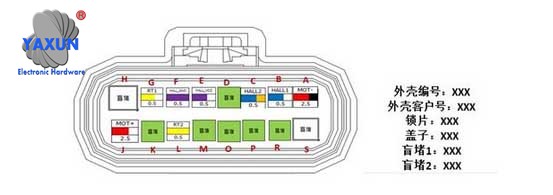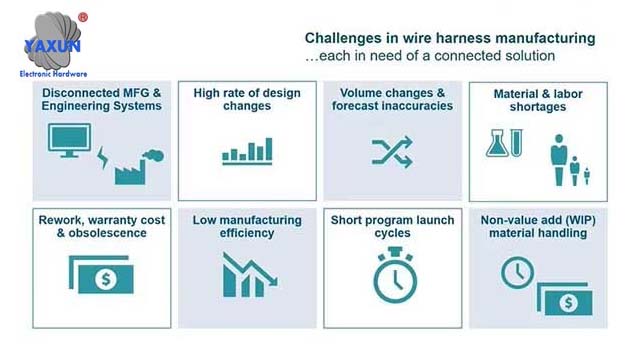In the wire harness manufacturing process, the size and output of the wire harness are the key to determining different types of assembly processes.
Regardless of the type of wire harness, a pre-assembly station is required, and some wire harnesses also include blind plugging stations. For simple pre-assembly of the circuit, there is no need to make a pre-assembly board, just hold it in your hand for work. Pre-assembled complex plates can be produced to facilitate operation and self-inspection. This requires a detailed pre-installed work instruction so that employees can clearly understand the work content. Usually a pre-assembly instruction book should reflect the following contents:
① Position of the instruction book
② Wire number, color, wire diameter, hole position
③ Shell number, hole location and simple schematic diagram

Wiring harness assembly workshop

Station assembly drawing of connecting terminals

Work station labels for wire harness assembly
Process control points, das heißt, key points or precautions (including rubber parts, Sensoren, diodes, locking, usw.)
⑤ If encapsulation is required, the type and length of the tape should be reflected
⑥ Blind plug number and hole location
⑦ Auxiliary tool number
The instruction book uses the simplest and easiest-to-understand expression (such as visualization) so that employees can work quickly and less easily make mistakes. Before inserting the terminal, employees should check the terminal blade and appearance, and follow the principle of “one push, two listens, and three pulls”. When a “click” is heard, it means that the terminal is inserted in place. If the pre-assembled part of the housing is fully inserted, locks, covers or cable ties must be installed. The assembled housing pulls the wires back and the wires should not be pulled out. Each work station must conduct self-inspection after completion.
There are many pre-installed wires and materials, and the types are relatively complex. Their placement needs to follow a certain logical organization and not hinder the operator. The placement of parts should be consistent with the order of operations in the work instructions, from left to right and top to bottom. Conductors with the same color and diameter at the same station should avoid being adjacent and should be separated as far apart as possible. Each part must be labeled, showing photos, part numbers, limited quantities and other information. There must be at least 2 material boxes to ensure that normal operations will not be affected when resupplying, and there must be a location for empty material boxes to be evacuated. Special markings should be provided for special wires (such as gold-plated or airbags) to alert employees. Endlich, after the pre-assembled branch is completed, it must be placed in a circle on the hanging pole or transfer trolley to facilitate the next step of the next station or final assembly.
From a broad perspective, the final assembly process can be roughly divided into three types: fixed plate, classic assembly line and “H”-shaped assembly line, and the special one is the flip plate.
For wire harnesses with few circuits and easy operation (such as car light wires, trunk wires, usw.), a fixing plate can be used. The number of boards can be increased or decreased according to the order volume, which is more flexible and convenient. As the number of circuits increases, when single boards cannot meet the output and production efficiency (such as engines, instrument panel lines, usw.), classic production methods such as dynamic assembly lines, 4-stations, and 8-stations are selected. But this is limited to the height of the board, and two operators are not allowed to perform parallel operations at the same time on one workstation. To solve this problem, the “H” shaped assembly line was created. This is especially suitable for wiring harnesses with complex circuits and many types of car models (such as body lines, interior cabins, usw.). The biggest disadvantage is that the rotation speed should not be too fast, as employees will suffer from motion sickness and will be tired when working with their heads down for a long time.
Pre-assembly and final assembly run through the entire wire harness assembly. Its production methods and division definitions are also particularly important, and also demonstrate the level of a process engineer. This is an endless road that requires continuous exploration and continuous improvement. I hope everyone can go further and further.
 English
English العربية
العربية Български
Български 中文(漢字)
中文(漢字) Čeština
Čeština Dansk
Dansk Eesti keel
Eesti keel Suomi
Suomi Français
Français Deutsch
Deutsch Ελληνικά
Ελληνικά עברית
עברית Magyar
Magyar Bahasa Indonesia
Bahasa Indonesia Italiano
Italiano 日本語
日本語 한국어
한국어 Latīna
Latīna Latviešu valoda
Latviešu valoda Lëtzebuergesch
Lëtzebuergesch Polski
Polski Português
Português Română
Română Русский
Русский Slovenščina
Slovenščina Español
Español Svenska
Svenska ภาษาไทย
ภาษาไทย Tiếng Việt
Tiếng Việt
